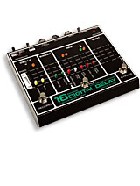
On several occasions, we’ve chronicled the story of Electro-Harmonix, from its first heyday in the 1970s, through the ’80s, and its resurgence in the ’90s. No doubt about it, company founder Mike Matthews is a survivor. And one of the reasons his company is still around is it’s constant upgrading of its classic products. The latest example of this effort is the newly reissued 16 Second Digital Delay.
Launched in the early days of digital music processing, the 16 Second Digital Delay delivered a healthy degree of versatility for the guitarist (and vocalist), whether in a studio or live setting. The new version is redesigned with modern components, and improves on the functionality in several ways. One example is in the interface; where the first units were more about numbers, the new one uses bars, beats, and tempo instead of seconds. You can create loops by setting the number of bars and the tempo.
Another cool new feature is the unit’s MIDI out. This allows you to use your 16-second performance and have a drum machine or sequencer automatically start and play in perfect synchronization. Having a MIDI tempo map is great for practice and creating longer loops – and your drum machine or sequencer’s tempo will automatically follow any tempo change you make on the 16 Second. Layer as much as you want, fix mistakes, and store your performances in the unit’s huge memory, then recall it even after powering down. It can also be used as a true delay echo and full-featured chorus.
We tested the unit with a 1972 Fender Stratocaster and a mid-’60s all-tube Vox Super Berkeley. After reading the instructions on basic loop setup, we played a two-bar rhythm pattern. In return, we got a clean-sounding identical pattern with no degradation. The metronome (E-H calls it “Clix”) gives a four-beat lead-in that lends accuracy to the process (and if you’re, um, “rhythmically challenged,” it’ll keep you on your toes). We started overdubbing, and even after laying down several tracks, we could hear all of them clearly until we finally had a ridiculous number laid on top of each other.
We then pushed the “Coarse” slider to 12 bars and had a good bit of fun jamming with each successive track. This is a great practice tool. The unit adjusts tempo without changing pitch, and the reverse switch does just what you’d think, replaying your licks, but backward. What a rush!
The echo and delay functions were also easy. From short slap-back delays to long echoes, the 16 Second was clean, even set to infinite repeat. This pedal could be looped into a PA as a high-quality delay. We also wanted to test the pedal’s sweep function, and pushing up the speed and depth controls revealed some of the nicest chorusing you’ll find anywhere – killer by itself, and even better with a little delay.
There is much a person could do with the 16 Second Digital Delay. The more we played with it the better we liked it, and as we finally unplugged, we walked away knowing we’d barely scratched the surface.
Electro-Harmonix 16 Second Digital Delay
Features Four-minute record time, pitch and tempo adjustment, loop reverse, controls for dry output, effect output, and click output, analog input gain control with signal and clip LEDs, three-footswitch control, optional remote footswitch.
Price $995.
Contact Electro-Harmonix/New Sensor, 32-33 47th Ave. LIC, New York NY 11101, phone (718) 937-8300, www.ehx.com.
This article originally appeared in VG‘s Jan. ’05 issue. All copyrights are by the author and Vintage Guitar magazine. Unauthorized replication or use is strictly prohibited.



